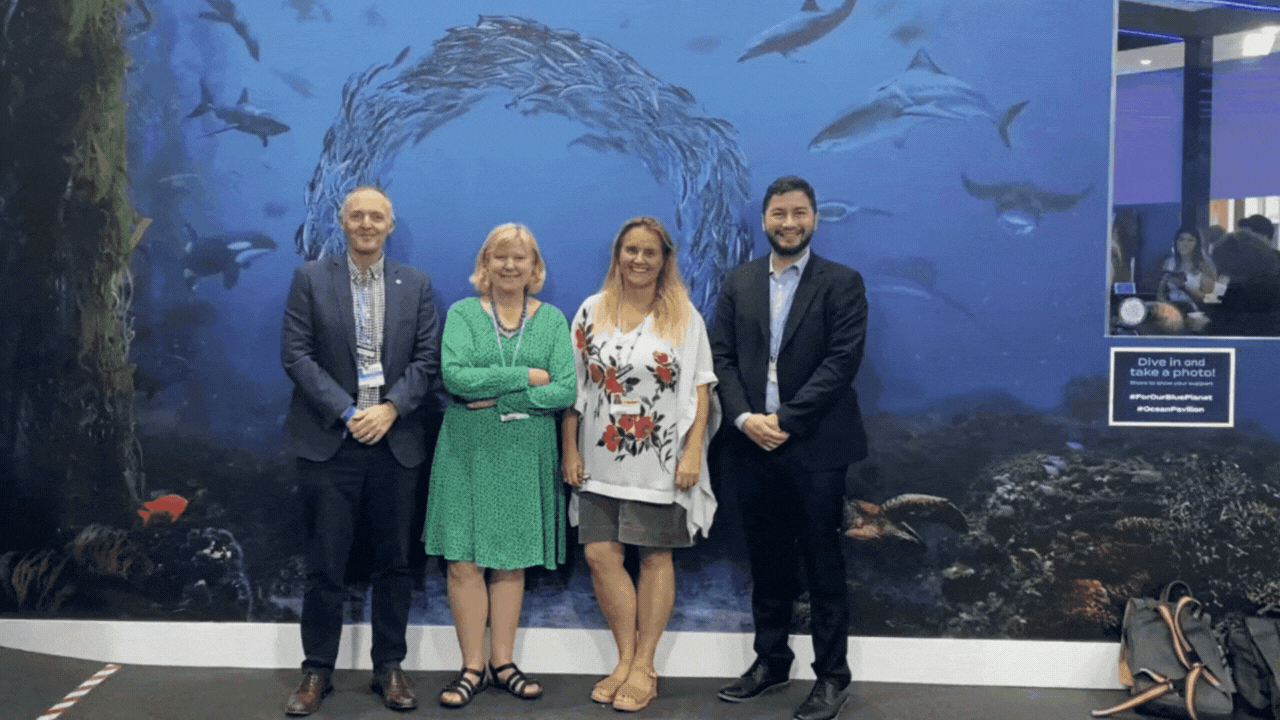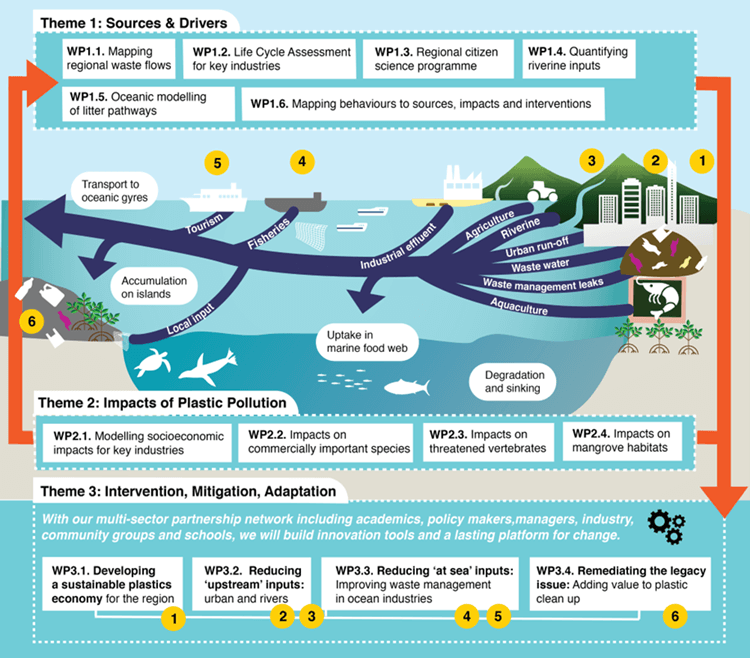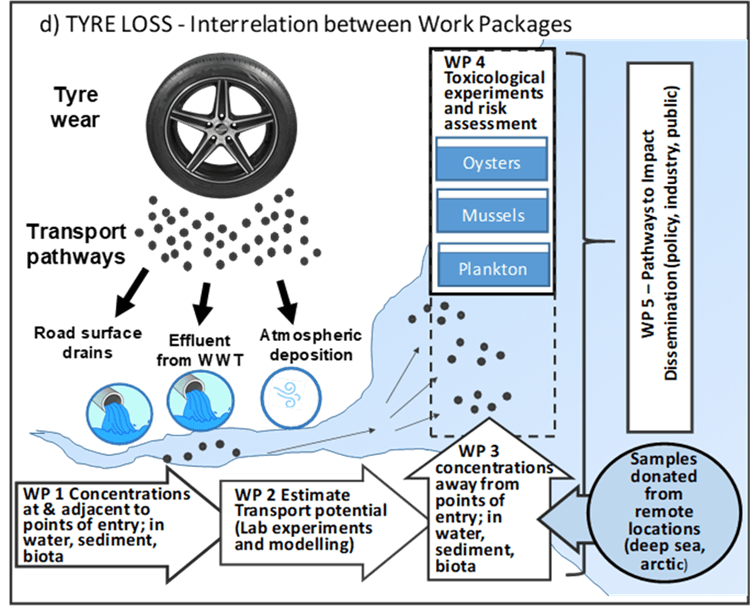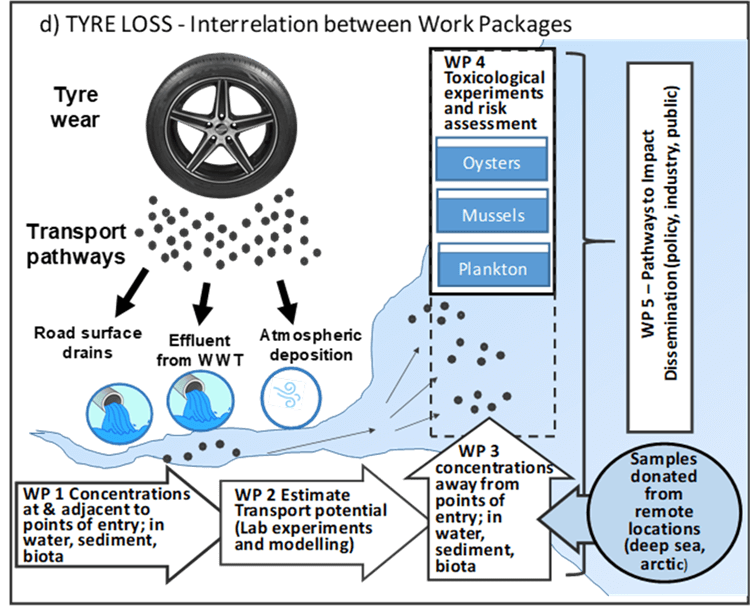WADIM: Water-Associated infectious Diseases in India: digital Management tools
Science Topic
Source to sea
The ocean, the land and freshwater ecosystems are closely interlinked and interdependent. Through applying a source-to-sea approach in our research we recognise this and aim to address knowledge gaps in support of the management of these connected ecosystems and tackling pollution at the source, upstream.
Plymouth Marine Laboratory (PML) is therefore proud that it was the first marine partner that joined the Action Platform for Source-to-Sea Management (S2S Platform), hosted and coordinated by the International Union for Conservation of Nature (IUCN) and with an ever growing membership.
“The source-to-sea approach recognizes that what we do on land and in rivers, lakes and aquifers can have impacts further downstream, along coasts and in the ocean. By taking these linkages into account, the approach applies a holistic view of the source-to-sea system, which will result in greater benefits for the entire system.”
[Source to Sea Platform – The IUCN Water Knowledge Platform]
The greatest strength of the S2S Platform, which until 2025 was hosted by the Stockholm International Water Institute, concerns the diversity of its diverse partner network with over 50 partner organisations all grounded in research, implementation and monitoring, towards strengthening the evidence-base concerning the source-to-sea approach in addressing persistent and rising issues such as climate change, freshwater and marine pollution, and biodiversity decline. The S2S Platform has brought the freshwater and ocean communities together at major occasions and supported policy makers and practitioners through the development and dissemination of knowledge materials, policy briefs and practical tools.
PML is supporting the S2S Platform through sharing its latest research findings and through partnering at science to policy events such as in relation to the UN Sustainable Development Goals, such as the UN Ocean and UN Water Conferences as well as the UN Climate Change meetings. Our research includes innovative approaches and real-world applications to monitoring and managing source-to-sea pollution towards achieving local, national and regional goals related to sustainable development. 

Pictured above: Plymouth Marine Laboratory (PML) meet with S2S Platform at COP27 in Egypt. (From left to right) PML’s Professor Steve Widdicombe (Director of Science), Ruth Matthews (Senior Manager / Coordinator) for the S2S Platform until 2025, Thecla Keizer (Deputy Head International Office & International Marketing and Business Development Executive at PML), and José Murillo of the S2S Platform until 2025.
PML’s Source to Sea research
Examples of source to sea projects can be found below, with links provided for further information and contact details for project leads should you have any questions.
- PML have been involved in research activities to investigate the transport of material from the River Tamar catchment to the Western English Channel seas since 2017 through UKRI-NERC funded projects such as LOCATE (Land-Ocean Carbon Transfer – 2017 to 2022) and AgZero+ (Towards sustainable, climate neutral farming – 2022 to 2027).
- AgZero+ Programme: PML is a partner in a major five-year £13.8 million research programme, named “AgZero+’, to support the UK’s transition towards home-grown food production that is sustainable, carbon-neutral and has a positive effect on nature. The programme will bring together a community of researchers and farmers to test innovative farming systems at scale. It will balance the need to produce nutritious food with reducing greenhouse gas emissions and pollution, while at the same time enhancing biodiversity and soil health (a holistic approach known as “net zero+’). Find out more >>
- LOCATE: The LOCATE project (Land-Ocean Carbon Transfer) was a research project to assess the scale of carbon being transported from land to ocean, running from 2017 – 2022. The project involved investigations of 40 UK rivers and 15 estuaries with particular focus on Tamar (England), Conwy (Wales) and Halladale (Scotland) catchments. Find out more >>
- PML researchers have been spearheading investigations of ecological and societal impacts of marine plastics since 2010, initially through pioneering and award-winning research on microplastics as an emerging pollutant and later expanding this to the wider plastics issue and assessing risk as well as developing nature-based solutions towards addressing the problem. Activities cover assessing and understanding the movement, fate and effects of marine plastics from microscopic characterization using Fourier-Transform Infrared Spectroscopy (FT-IR) to satellite detection of hotspots, modelling the transport of plastics across the ocean, as well as translating the societal and economic impacts to plastic.
- Pacific Plastics Science to Solutions (PPSS): Reducing the impacts of plastic waste in the Eastern Pacific Ocean


Plastic pollution is getting worse in this region and globally, and this project will map the sources of plastic waste, investigate its effects and generate solutions to reduce waste.
Researchers will work with governments, businesses, charities, local scientists and communities to "co-design" effective, long-lasting ways to cut plastic pollution
The four-year project has received a £3.3 million grant from UK Research and Innovation’s Global Challenges Research Fund. It is led by the University of Exeter and the Galapagos Conservation Trust with PML involvement. The project team also contains seven universities from Ecuador, Peru and Chile, and an extensive network of collaborators across multiple sectors and all stages of the lifecycle of plastics. Find out more >>
Lost at Sea: where are all the tyre particles? (TYRE-LOSS) Project: Bringing together the Universities of Plymouth, Exeter and Newcastle, together with PML, the research from this project aims to quantify tyre particle concentrations at their points of entry to the marine environment.
It will then explore how far they can spread, and any harm they might cause, by measuring concentrations in the sediment, water and biota up to 15km from the shoreline.
It indicated up to 100million m² of the UK’s river network – and more than 50million m² of estuarine and coastal waters – are at risk of contamination by tyre particles. Find out more >>
- Pacific Plastics Science to Solutions (PPSS): Reducing the impacts of plastic waste in the Eastern Pacific Ocean
- Floating Litter and Plant Patch Remover (FLiPPR) and River Plastic Plants Lifter (RiPPL) Projects: Rivers are a main source of marine plastic litter. In tropical and subtropical countries, rivers are also negatively impacted by invasive water hyacinth Eichhornia crassipes, a prolific fast-growing floating plant. In Vietnam, research by project partners at the University of Wageningen (WUR) has shown that ~78% of floating river plastics become entrapped in hyacinth patches and transported downstream to coastal waters. These large, free-flowing ‘plastic-plant’ patches persist at the river surface throughout the year, with seasonal variations. Once out of the water, hyacinth is an economically valuable product that can be used to make household items, compost, and animal feed. In the Varuna River in India, FLiPPR and RiPPL have consolidated satellite remote sensing, field work studies, artificial intelligence, local expertise, and mechanical engineering to enable intelligent but low-cost removal of plastic litter, debris, and invasive water hyacinths before they flow into the Ganges. The aim is to prevent plastics from reaching the ocean, but the work also serves to improve ecosystem health, freshwater quality, and navigability of the rivers themselves. This is a collaborative effort between PML, Plastic Fischer, Wageningen University and Poseidon Data, and was financed by the Norwegian Retailers’ Environment Fund (Handelens Miljøfond). NOAA and Adidas also supported this project through provision of satellite imagery and testing of recovered hyacinth as shoe material, respectively.
- Closing the Loop Project: In support of the local implementation of the ASEAN Framework of Action on Marine Debris, as well as the commitment of G20 leaders to tackle the proliferation of plastic litter through the Osaka Blue Ocean Vision, the Closing the Loop (CTL) project aims to help cities make their plastic waste management processes more circular, increasing the recycling and reuse of plastics and reduce their leakage into the marine environment. CTL, undertaken by the UN ESCAP in partnership with the Government of Japan, have developed a free eLearning course on “Innovative Approaches to Measuring and Managing Marine Plastic Pollution in Cities’. PML and partners developed Module Four on “Detecting Waste from Land and Space’ which focuses on innovative plastic monitoring tools, including from space, to gain greater evidence and understanding of urban plastic pollution. PML have also been successfully applying these tools in the Saigon River around Ho Chi Min city on multiple scales, with transferability of techniques to other rivers in the PEMSEA region (and beyond). Uptake of the module was in support of increasing plastics pollution literacy and enhanced global, but particularly Asian, uptake of this free eLearning tool as well as the innovative plastic monitoring tools. The overall aim was gaining greater evidence and understanding of urban plastic pollution, towards ultimately reducing the pollution reaching and impacting the marine environment.
- Risks and Solutions – Marine Plastic in SE Asia: PML, SE Asia has been identified as the third largest regional generator of mismanaged plastic waste in the world. If no significant efforts are made to manage this, plastic waste inputs could double by 2060. This challenge requires a regional scale approach that allows environmental, economic, technical, and social disciplines to come together to build understanding of the many factors contributing to the problem, its potential impacts, and identify how it can be solved. Our network has strong relationships with Research Institutions, National Park managers, and Environment Ministries in each country. Our vision is to reduce plastic leakage in the Southeast Asian region, supporting development of a sustainable, circular economic system for plastics. We propose an integrated, multidisciplinary project with three core aims. We will establish the sources and drivers of plastic pollution including the mapping and life cycle of plastic waste flows across the region and how it moves once in the marine environment. Secondly, we will identify the key economic, ecological, and health and wellbeing impacts of the current levels of plastic pollution that pervades this region. Thirdly, we will implement and explore interventions to mitigate and reduce plastic pollution and help progress the region to circular approaches to plastic.
- The Economics of Marine Plastic Pollution: What are the Benefits of International Cooperation? The physical properties and uncertainties associated with marine plastic, combined with the transboundary nature of the problem and a lack of international markets for control (such as an emissions trading scheme), has led to a lack of effective global actions to address the challenge of marine plastic. Recognizing this critical and unresolved problem, the fundamental aim of the proposed research is to bring new insights to bear on the economic damages associated with marine plastic, the costs of reducing this pollution problem, the net benefits of international coordination over reductions in marine plastic, and the conditions under which mutually beneficial coordination can occur.
- The project will be organised around four research questions, focused on the North Atlantic as a case study:
- What is the probable spatial distribution and movement of marine plastic and what are the associated ecological impacts?
- What are the economic damage costs associated with marine plastic, for a range of North Atlantic countries?
- What are the costs of reducing both the stock and the flows of plastic in/into the marine environment of the North Atlantic?
- What are the economic benefits of different levels of international cooperation in emissions reductions, and what does this imply about incentives to cooperate?
- The project will be organised around four research questions, focused on the North Atlantic as a case study:
PML Projects
BIO-PLASTIC-RISK: Biodegradable Bioplastics – Assessing Environmental Risk
ProBleu: Promoting ocean and water literacy in school communities
FRONTAL: Satellite FRONTs for detection of Anthropogenic plastic Litter
FutureMARES: Climate Change and Future Marine Ecosystem Services and Biodiversity
Atlantic Ecosystem Assessment, Forecasting and Sustainability (AtlantECO)
Copernicus Evolution: Research for harmonised and Transitional water Observation (CERTO)
The Economics of Marine Plastic Pollution: What are the Benefits of International Cooperation
Pathways Of Dispersal for Cholera And Solution Tools (PODCAST)
Changing Arctic Carbon cycle in the cOastal Ocean Near-shore (CACOON)
Pathways and emissions of climate-relevant trace gases in a changing Arctic Ocean (PETRA)































